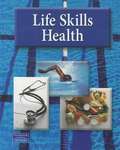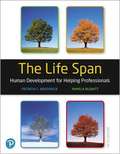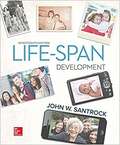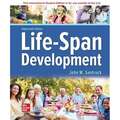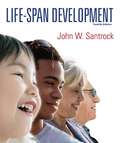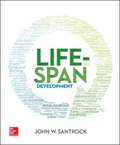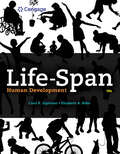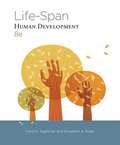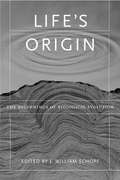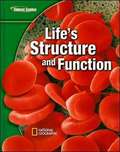- Table View
- List View
Life Science Student Lab Manual
by Jeff S. Foster Elizabeth A. LacyIncorporates activities into reading and learning the concepts discussed in class. This mainly involves lab manual applications and investigations.
Life Shaping Decisions: A Career Planning Manual for Christian Young Adults
by Rick HornePlanning for a career is fraught with challenges and decisions to think through carefully. This workbook from ACSI is designed to help teenagers think through all the possibilities of their actions, including choosing a career, determining the will of God, and career stewardship.
Life Skills for the 21st Century: Building a Foundation for Success
by Suzanne Weixel Faithe WempenResponsible living skills presented in an engaging and bold style. Today's world asks students to balance a wide range of responsibilities -- from succeeding in school, to building personal relationships, to beginning a career, to giving back to their community. Life Skills for the 21st Century: Building a Foundation for Success gives students the tools and confidence to think critically about the choices they make, take control of their lives, and ultimately achieve their goals. Designed in a unique magazine format that speaks to today's student and written to meet state FACS standards, this engaging, contemporary, user-friendly first edition text focuses on shaping and sustaining the five critical and interdependent areas of responsible living: family, peers, school, work, and community.
Life Skills Health
by American Guide A. G. S. SecondaryA skill-based, wellness approach to health - Life Skills Health-a textbook for striving high school students--discusses critical health concepts. Students learn how to maintain positive mental health, deal with emotions, prevent sexually transmitted diseases and common diseases, implement good nutrition and exercise plans, and more. The text sharpens students' abilities to set goals and make decisions. In addition, Life Skills Health explains how to sustain healthy relationships, communicate effectively, and access health resources. Throughout Life Skills Health, simple sentence structure and assistance with difficult vocabulary work together to enhance comprehension. This exciting, full-color textbook provides student-friendly text and real-world examples to show students the importance of sound health strategies in their daily lives. The text also invites students to view health issues from a global perspective with Health in the World features.
Life Skills Math
by Donald H. Jacobs August V. TreffWelcome to Life Skills Math. This book includes many of the math skills that you will need now and later in life. Why do you need these skills? Think about the world of mathematics around you. When you buy something, you use math to count money. When you measure something, you use numbers to calculate units of measurement. Most jobs require at least some sort of math. You will use the basic math skills in this book almost every day of your life at home, at school, and on the job.
The Life Span: Human Development for Helping Professionals
by Patricia Broderick Pamela BlewittThe Life Span: Human Development for Helping Professionals, 5th Edition, provides an in-depth look at the science of human development, highlighting theories and research that have useful applications for individuals working in fields such as education, counseling, and social work. The main purpose of this book is to provide the reader with information that can be translated into professional best practice applications. Throughout, the text reflects the contemporary view that life span development is a process deeply embedded within and inseparable from the context of family, social network, and culture. Because the book is designed for graduate students, most topics, especially those that have special relevance to helping professionals, are covered in greater depth than in a typical life span text. The expanded coverage of research in these areas will enhance readers’ understanding of the scientific basis for application to practice. Because the book is designed for graduate students, most topics, especially those that have special relevance to helping professionals, are covered in greater depth than in a typical life span text. The expanded coverage of research in these areas will enhance students'' understanding of the scientific basis for application to practice. The Enhanced Pearson eText features embedded video to illustrate key concepts and pop-up assessments to help students assess their proficiency.
Life Span Development
by John SantrockJohn Santrock connects current research with real-world application, helping students see how developmental psychology plays a role in their own lives and future careers. Through an integrated learning goals system, this comprehensive and chronological approach to lifespan development helps students gain the insight they need to study smarter, stay focused, and improve performance.
Life-Span Development
by John SantrockAs a master teacher, John Santrock connects current research with real-world application, helping students see how developmental psychology plays a role in their own lives and future careers. Through an integrated learning goals system, this comprehensive and chronological approach to lifespan development helps students gain the insight they need to study smarter, stay focused, and improve performance.
Life-Span Development (12th edition)
by John W. SantrockPrevious editions of this text have been widely adopted for their accurate, complete, and up-to-date coverage. While maintaining these hallmarks, this revision includes increased coverage of adulthood and aging, a new Interlude feature on applications, and updated research with more 21st-century citations.
Life-Span Development (15th Edition)
by John W. SantrockThe book intends to provide students with the best and most recent theory and research in the world today about each of the periods of the human life span and guide them in making developmental connections across different points in the human life span.
Life-Span Human Development
by Carol K. Sigelman Elizabeth A. RiderPacked with the latest research and vivid examples, Sigelman and Rider's LIFE-SPAN HUMAN DEVELOPMENT, 10th edition, equips you with a solid understanding of the overall flow of development and the key transformations that occur in each period of the life span. Written in clear, straightforward language, each chapter focuses on a domain of development -- such as cognitive or personality development -- and traces developmental trends and influences in that domain from infancy to old age. Sections on infancy, childhood, adolescence and adulthood are included. The text emphasizes theories and their use in helping us understand development, focuses on the interplay of nature and nurture in development, and also provides an expansive examination of both biological and sociocultural influences on life-span development. Additionally, MindTap digital resources offer anywhere, anytime learning solutions.
Life-Span Human Development (Eighth Edition)
by Carol K. Sigelman Elizabeth A. RiderKnown for its clear, straightforward writing style, comprehensive coverage, strong and current research-based approach, and excellent visuals and tables, this life-span development text offers a topical organization at the chapter level and a consistent chronological presentation within each chapter. Each chapter focuses on a domain of development such as physical growth, cognition, or personality, and traces developmental trends and influences in that domain from infancy to old age. Within each chapter, you will find sections on four life stages: infancy, childhood, adolescence, and adulthood. This unique organization enables students to comprehend the processes of transformation that occur in key areas of human development. Another staple of the text is its emphasis on theories and how they apply to specific topics in each chapter. This new edition also asks students to engage more actively with the content, and includes a clear focus on the complex interactions of nature and nurture in development, more integrated coverage of culture and diversity, and an exciting new media package for both students and instructors.
Life-Span Human Development (Ninth Edition)
by Carol K. Sigelman Elizabeth A. RiderKnown for its clear, straightforward writing style, grounding in current research, and well-chosen visuals and examples, Sigelman and Rider's text combines a topical organization at the chapter level and an age/stage organization within each chapter. Each chapter focuses on a domain of development such as physical growth, cognition, or personality and traces developmental trends and influences in that domain from infancy to old age. Each chapter also includes sections on infancy, childhood, adolescence, and adulthood. The organization helps you grasp key transformations that occur in each period of the life span. Other staples of the text are its emphasis on theories and their application to different aspects of development and its focus on the interplay of nature and nurture in development. This edition includes new research on biological and sociocultural influences on life-span development and offers new media resources that help you engage more actively with the content.
Life Structure and Function (Inspire Science #Grade 6 Integrated, Unit 1)
by Alton L. Biggs Ralph M. Feather Jr. Douglas FisherNIMAC-sourced textbook
Lifeguard Dogs to the Rescue (Fountas & Pinnell Classroom, Guided Reading)
by Judith StamperNIMAC-sourced textbook
Life's Origin: The Beginnings of Biological Evolution
by J. William SchopfThis volume explores the historical and current theories about the origin of life, addressing in particular the three key puzzles of how and when life began on Earth and in what form.
Life's Structure and Function
by Glencoe Mcgraw-HillDiscover the Flexibility to Teach Science Your Way!. "Glencoe Science: Life's Structure and Function," a module in the Glencoe Science 15 book series, provides students with accurate and comprehensive coverage of middle school National Science Education Standards. Concepts are explained in a clear, concise manner, and are integrated with a wide range of hands-on experiences, critical thinking opportunities, real-world applications, and connections to other sciences and to non-science areas of the curriculum. Co-authored by National Geographic, unparalleled graphics reinforce key concepts. A broad array of print and technology resources help differentiate and accommodate all learners. The modular approach allows you to mix and match books to meet your specific curriculum needs..
Lifeskills Training: Promoting Health and Personal Development
by Gilbert J. BotvinLifeskills Training Middle School Rev Ed Level 1 Student Guide
LifeSkills Training: Promoting Health and Personal Development, High School Student Guide
by Gilbert J. BotvinNIMAC-sourced textbook

